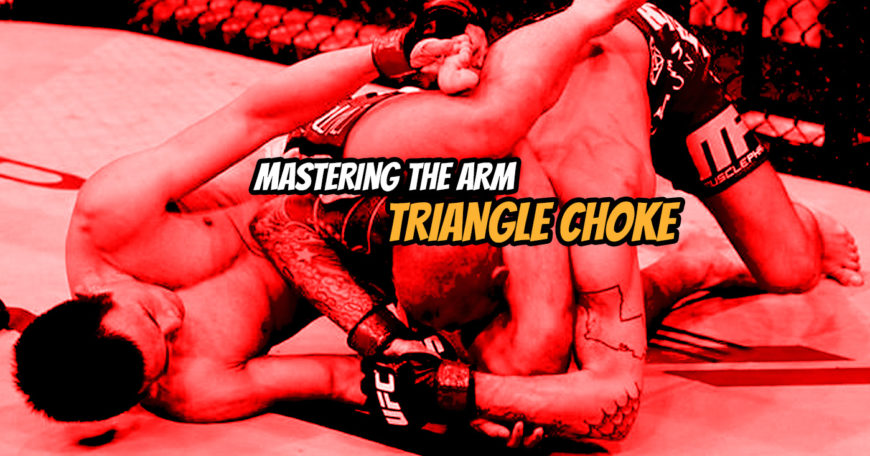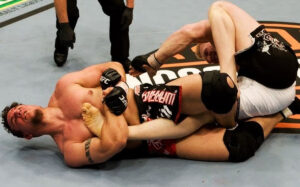The ‘arm-triangle choke’ is a core submission of Brazilian Jiu-Jitsu (BJJ) that is simple to learn but is also incredibly effective and powerful. This technique is taught to white belts early on in their training but can take a long time to grasp all setups and variations fully. However, this choke carries a high submission rate and incredible versatility, so it is definitely one to master, no matter how long it takes.
All arm-triangle chokes are blood chokes. This means that they inhibit or stop blood flow between the heart and the brain, which is otherwise known as a stranglehold. Blood chokes are not precisely the same as chokeholds. The latter prevents the flow of oxygen to the brain, but not necessarily blood flow. Triangle chokes are defined by applying pressure on both sides of the neck, which in turn restricts the carotid arteries.
The result is a loss of consciousness caused by a lack of oxygenated blood to the brain. In an arm-triangle choke, your bicep and your opponent’s shoulder are used to form a triangle around their neck to cause the constriction.
The term ‘arm triangle‘ (also known as ‘head and arm choke’ or ‘side choke’) is often associated with the ‘Kata Gatame‘ choke, which has its roots in Judo. However, there are many variations to this stranglehold, and it’s crucial to be able to distinguish which one is best used in each situation. Despite the incredible variety, the good news is that the mechanics tend to remain the same, so learning even just one variation will pay huge dividends in the future.
Although ‘top mount’ is the most favored position to initiate this choke, often beginners and intermediates end up in less powerful positions, such as side control. Although this is not usually desired by advanced practitioners, as a beginner, it is an excellent way to start an arm-triangle choke. This choke can be obtained from multiple angles, positions and setups.
Here we take at one of the most basic and most advanced variations and the best defense for this terrifying technique.
Front Arm Triangle:
The most basic triangle choke is the ‘Kata Gatame.’ Also known as the ‘front arm triangle,’ this variation works when both you and your opponent are facing each other, which is possible in either full mount or side control.
1– From mount (sitting on top of your partner), lower yourself onto your opponent so that you are chest to chest. Place your palms on the floor on either side of their head, with your elbows pointing outwards. As your opponent attempts to push you off or defend themselves, look for an opportunity to get one of your arms beneath one of their elbows. Once secured, walk your fingers forward, raising their arm and elbow up and away from their body. Simultaneously scoop your other arm under their head and beneath their neck in a hook shape (‘captain hook’).
2– Get a firm grip of their head with the hooked arm and turn their head to the side so that it it faces inwards. Reach the same arm a little further until you have a grip on their opposite shoulder. Your opponent’s elbow should now be across their face.
3– Use your head to trap their shoulder by squeezing your ear against their forearm. Use your free hand to pull their arm down from their face and onto their neck. Secure their shoulder once again (against their neck) and hold it in place with your head.
4– Shift your weight forward onto their chest and bring your leg (on the hooked arm side) across the body and sprawl your legs. Close your triangle choke by gripping your hands together. Finally, begin to walk your feet towards your head, tightening the choke, until your opponent taps.
Side Control:
1– Using side control to achieve this technique is also a common practice. From this starting position, you will need to gain the ‘captain hook’ arm underneath your opponent’s neck. You may have to wait for an opening to do this. One possible opportunity is when your opponent pushes against you to create space so that they can escape.
2– Once you secure the hook, they will try to fight you off with their free arm. If they extend it to push your face away you can press your head in against their shoulder and secure the second arm that way.
3– Lock your hands into a gable grip (palm to palm) and squeeze the choke until your partner submits.
Other alternative positions include closed guard, bottom half guard and standing. The first two are seen more often due to their relative simplicity. However, the arm-triangle choke is one of the most difficult to pull off and is therefore uncommon to see in regular practice.
This is also due to the fact that it needs a point of strength to maintain it, which is difficult in BJJ, but not so much in MMA where the cage can be used to do this instead. Despite the potential difficulty, it is an excellent way to start a takedown.
Standing Arm Triangle:
It’s best to work off an opponent’s attack to set up this strike. Make sure you are both in your stances.
1– When your partner throws a jab, duck and slip your head outside the punch, while using your lead arm to reach for their shoulder and hook it around their neck.
2– Follow up quickly with your rear hand reaching to meet your other to secure a gable grip at the beach of their neck. Be sure to keep your head up straight so that your jaw is against their shoulder.
3– Look up and lean your body backwards to finish the submission
Defense:
It’s common for beginners to find themselves trapped by an arm-triangle choke. This is in part due to a large number of variations and setups for this technique; it can be tricky to read in advance. Luckily, there are also a decent number of ways to escape the choke. As stated earlier, beginners often lose their top mount position to a more experienced training partner, and while it can be difficult to escape an armbar from here, it is not impossible.
1- The best way to defend the triangle choke is to prevent it from happening. Even if your partner has hooked one arm behind your neck, you still have one free arm and what you do with that arm is very important to your success.
Fighting back by pushing against their body with your remaining arm is easy access for them to finish the submission. Instead, try hugging your arms around their body and neck and pulling them in and exploring your options there.
2- If, however, your opponent is in the process of setting up the finish, you have one final option before it is too late. Before they have gripped their hands together, grab the wrist of the arm that is locked in the choke to create an ‘arm frame’.
3- While they are still mounted, push the trapped arm above and over their head before driving it down to create a space between their arm and your body.
4- Turn onto your side (facing opponent) and immediately bring your elbows back in so that they are held tightly against the body. Although you have escaped the arm-triangle choke, it is still important to get out from under their mounted position. From here you can perform an ‘elbow escape’, or trap their arm and roll yourself into top mount position.
If you find yourself being strangled by the triangle, it is almost impossible to get out of but an arm frame can still be attempted, although it is harder to be successful in this instance. Use your free arm to remove the trapped one from your partner’s head and force the arm down between both of you.
Make sure to bring your elbows back on the inside for safety. From here, you can work another escape to get you back into a more favorable position like side control or top-mount.
Related: BJJ Fundamentals: How To Do A Triangle Choke.
Conclusion:
The arm-triangle choke is fundamental in any practitioner’s arsenal. Although it is introduced at a beginner level, it should be seen as a technique to constantly develop and improve upon as you advance through the belt rankings. With an endless variety of angles and positions to work from and the ability to add refinements as you learn, it will continue to pay dividends throughout your training duration.









